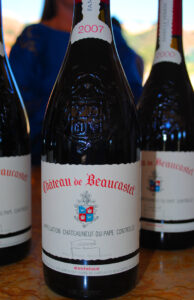2007 Chateau de Beaucastel, Chateauneuf-du-Pape Rouge “Oenotheque” Rhone Valley, France.
As I finish a month long look back and or at classic bottlings from the wine world I couldn’t leave out this beauty from the Perrin family and praise this series of Eonotheque offerings that were released by the legendary Chateauneuf-du-Pape’s Chateau de Beaucastel cellar. These perfect condition late release Eonotheque include a range of vintages, I was able to check in on many of them, including 1995, 2000, 2014, one of my favorite off year vintages, 2009, which is showing remarkably better than the regular release and this powerful 2007, a wine I always loved with its intense Mourvedre component really integrating perfectly now, taming the fruity Grenache and making for much more complex and detailed wine. The Château de Beaucastel is one of France’s greatest wines, with vines at the northern end of the Chateauneuf-du-Pape appellation, the country’s first AOC and known mainly for their iconic and classic blend of red Rhone varietals, as well as producing one of the world’s greatest Roussanne single varietal wine. The terroir is, as the winery notes, archetypal of the best terroirs in Châteauneuf, which has warm days and cool nights with the Mistral winds helping refresh the vines that are set on rolled pebbles and galets (the famous round stones) on the surface, with sand, clay and limestone deeper down. These Beaucastel vines are old and have been organically farmed for more than half a century, which has, as the winery adds, allowed the roots to grow exceptionally deep, increasing the concentration and depth of flavors.
Beaucastel grows all thirteen grape varieties authorized by the appellation with the Chateauneuf seeing all them in the blend, with the Rouge being made up of Grenache 30%, Mourvèdre 30%, Syrah 15%, Counoise 10%, along with a combination of Vaccarèse, Terret Noir, Muscardin, Clairette, Picpoul, Picardan, Bourboulenc and Roussanne adding up to 10%, as well as 5% of Cinsault. Beaucastel says they hand harvest and careful sort each grape separately and the vinification is done in oak fermenters for the more reductive varieties Mourvèdre and Syrah and the rest in traditional enameled concrete tanks.The wines at Beaucastel have got much more polished and clean in the last 20 years, they largely are way removed from the funky barnyard style of the 1980s and early 1990s. After the primary and malolactic fermentation(s) are complete, the winemakers blend the wines, then once the final selections are put together it is then aged in large, mostly used oak Foudres for a 12 months. Once the Chateauneuf is bottled, some of wine is set aside for long term cellar resting which is what the Oenotheque is all about, while most of the bottles are put out to the market for regular release. The 2007 is coming into its prime drinking window and the fruit is still fresh on the full bodied palate with dense layers of rich red berry compote, plum, strawberry preserves and morello cherry along with hint of leather, game, licorice, dusty spices, chalky stone, cedar and a sticky potpourri of lavender and dried flowers. This deeply garnet colored Chateauneuf has plenty of stuffing and structure to age another decade, though it would be fabulous choice for this years’ holiday season and great with meaty winter cuisine. As this wine shows, mid term cellaring really pays off with Chateauneuf(s) and I love wines like Vieux Telegraphe, Pegau and Beaucastel, to name a few, with 10 plus years on them.
($120 Est.) 95 Points, grapelive
